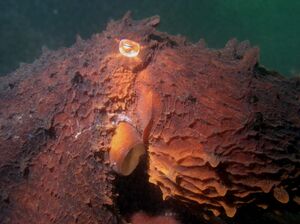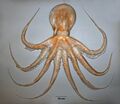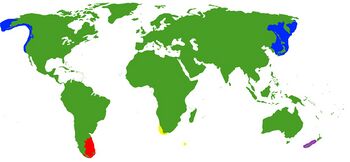أخطبوط عملاق
| الأخطبوط العملاق | |
|---|---|

| |
| أخطبوط المحيط الهادي العملاق تظهر طيات طولية وحليمات تشبه المجداف، المميزة للجنس. | |
| التصنيف العلمي | |
| أصنوفة غير معروفة (أصلحها): | الحياة |
| مملكة: | الحيوانية |
| Phylum: | رخويات |
| Order: | أخطبوط |
| Family: | الأخطبوطيات العملاقة |
| الجنس: | الأخطبوط العملاق روشبرون & مابيل، 1889 |
| Type species | |
| الأخطبوط الپتاگوني الأحمر گولد، 1852
| |
| أنواع | |
| |
الأخطبوط العملاق (Enteroctopus، أو Giant octopus)، هو جنس من رخويات ضمن رتبة الأخطبوطيات، يتميز بحجمه الكبير. يتضمن هذا الجنس أربعة أنوع فقط، وهي أخطبوط المحيط الهادي العملاق، الأخطبوط الجنوبي العملاق، الأخطبوط الپتاگوني الأحمر، والأخطبوط النيوزيلندي الأصفر. ينتشر الأخطبوط العملاق في المناطق المعتدلة من نصف الكرة الشمالي والجنوبي.
التسمية
The generic name Enteroctopus was created by Alphonse Tremeau de Rochebrune and Jules François Mabille in 1887 and published in 1889,[1] joining Ancient Greek ἔντερον 'gut' and ὀκτώπους, thus 'octopus [with arms similar to] guts.'[2]
الوصف
Enteroctopus is a genus of generally temperate octopuses. Members of this genus are characterized by their large size and are often known as giant octopuses. Enteroctopus species have distinct longitudinal wrinkles or folds dorsally and laterally on their bodies. Their heads are distinctly narrower than the mantle width. The hectocotylus of the males in this genus, found on the third right arm, is long and narrow in comparison with other genera in the family Octopodidae, often comprising one-fifth the length of the arm. Octopuses in this genus have large, paddle-like papillae instead of the more conical papillae in other octopus genera.[3][4]
الأنواع
يتضمن جنس الأخطبوط العملاق أربعة أنواع:[5]
| Image | الاسم بالعربية | الاسم باللاتينية | الانتشار |
|---|---|---|---|
 |
أخطبوط المحيط الهادي العملاق | Enteroctopus dofleini | الساحل الشمالي للمحيط الهادي، على امتداد سواحل كاليفورنيا، أوريگون، واشنطن، كولومبيا البريطانية، وألاسكا، روسيا، اليابان، وشبه الجزيرة الكورية |
| الأخطبوط الجنوبي العملاق | Enteroctopus magnificus | سواحل ناميبيا وجنوب أفريقيا. | |
 |
الأخطبوط الپتاگوني الأحمر | Enteroctopus megalocyathus | الساحل الجنوبي الشرقي لأمريكا الجنوبية على امتداد سواحل الأرجنتين وتشيلي حتى أرخبيل تشيلوي وجزر فوكلاند |
 |
الأخطبوط النيوزيلندي الأصفر | Enteroctopus zealandicus | المياه المحيطة بنيوزيلندا. |
الأنواع النمطية
E. membranaceus has often been regarded as type species of the genus, not because it was designated as such by Rochebrune and Mabille when they erected the genus, but because it was the first named species in the genus. Robson in his 1929 monograph of octopods regarded E. membranaceus as a species dubium because the original description was insufficient to identify an individual species, the holotype was an immature specimen, and the type specimen no longer existed.
As such, the genus was considered invalid until Hochberg resurrected it in 1998. Hochberg noted that Robson had considered E. membranaceus a junior synonym of E. megalocyathus, the second species assigned to the genus by Rochebrune and Mabille in their 1889 description. Additionally, since Rochebrune and Mabille did not actually assign type status to E. membranaceus, Hochberg concluded that Enteroctopus was indeed a valid genus and transferred type-species status to E. megalocyathus based on his conclusion that E. megalocyathus and E. membranaceus are the same species.[3]
الانتشار
Species in the genus Enteroctopus are restricted to the temperate areas of the Northern and Southern Hemispheres. E. dofleini is the only member of the genus found in the Northern Hemisphere, and also the most widely distributed: It is found from Southern California, along the North Pacific Rim to Japan, including the Okhotsk and Bering Seas.[3] The other three species are found in the Southern Hemisphere; E. megalocyathus occurs on the southeastern coast of South America,[6] E. magnificus on the southwestern coast of Africa from Namibia to Port Elizabeth, South Africa, and E. zealandicus in temperate New Zealand.[4]
الحجم
The member of this genus that best embodies the common name "giant octopus" is Enteroctopus dofleini, which holds the record of being the world's largest octopus based on direct measurements of a 71 كيلوغرام (157 رطل) individual, weighed live.[7][أ] This octopus had a total length near to 3.5 متر (11 أقدام). The remaining members of the genus are substantially smaller, with E. megalocyathus having an average mass of 4 كيلوغرام (8.8 رطل) and reaching a total length of 1.0 متر (3.3 أقدام).[9][10] E. magnificus reaches a total length of around 1.5 متر (5 أقدام).[4]
انظر أيضاً
مرئيات
| أخطبوط عملاق عُثر عليه على إحدى شوطئ جزيرة لومبوك، إندونيسيا، 3 يونيو 2024. |
الهوامش
- ^ The size record is held by an E. dofleini specimen that was 9 متر (30 أقدام) across and weighed more than 270 كيلوغرام (600 رطل). Averages are more like 5 متر (16 أقدام) and 50 كيلوغرام (110 رطل).[8]
المصادر
- ^ Bieler R, Bouchet P, Gofas S, Marshall B, Rosenberg G, La Perna R, Neubauer TA, Sartori AF, Schneider S, Vos C, ter Poorten JJ, Taylor J, Dijkstra H, Finn J, Bank R, Neubert E, Moretzsohn F, Faber M, Houart R, Picton B, Garcia-Alvarez O, eds. (2022). "Enteroctopus Rochebrune & Mabille, 1889". MolluscaBase. World Register of Marine Species. Retrieved 12 December 2022.
- ^ Rochebrune, Alphonse-Tremeau de; Mabille, Jules François (1889). Mission scientifique du cap Horn, 1882-1883 (in الفرنسية and اللاتينية). Paris: Gauthier-Vallars. p. 7. Retrieved 9 December 2022.
[...] brachiis longissimis, intestiniformibus [...]
- ^ أ ب ت Hochberg, Frederick (Eric) George (1998). "Enteroctopus; Enteroctopus dofleini Wülker, 1910 new combination". In Valentich Scott, Paul; Blake, James A. (eds.). Taxonomic Atlas of the Benthic Fauna of the Santa Maria Basin and the Western Santa Barbara Channel. Vol. 8. Santa Barbara, CA: Santa Barbara Museum of Natural History. pp. 203–208. ISBN 0-936494-13-1.
- ^ أ ب ت Norman, M. (2003). Cephalopods: A world guide. Heckenhaim, Germany: Conch Books. pp. 213–216.
- ^ قالب:Cite periodical
- ^ "CephBase: Countries' exclusive economic zones with Enteroctopus megalocyathus". Archived from the original on 5 سبتمبر 2006. Retrieved 30 ديسمبر 2007.
- ^ Cosgrove, J. A. (1987). Aspects of the natural history of Octopus dofleini, the giant Pacific octopus. Department of Biology (M.Sc. thesis). Victoria, Canada: University of Victoria.
- ^ "Animals. Reference. Giant Pacific Octopus". National Geographic. Archived from the original on February 19, 2021. Retrieved 25 August 2022.
- ^ Perez, M. C.; Lopez, D.A.; Aguila, K.; Gonzalez, M. L. (2006). "Feeding and growth in captivity of the octopus Enteroctopus megalocyathus [Gould, 1852]". Aquaculture Research. 37: 550–555.
- ^ Gleadall, I. G.; Salcedo-Vargas, M. A. (2004). "Catalogue of the cephalopoda specimens in the zoology department of Tokyo University Museum". Interdisciplinary Information Sciences. 10: 113–142.
